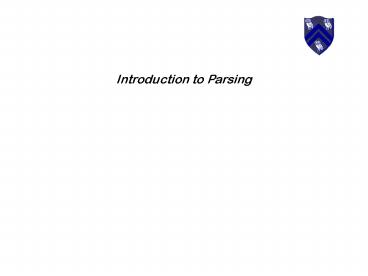Introduction to Parsing - PowerPoint PPT Presentation
Title:
Introduction to Parsing
Description:
Checks the stream of words and their parts of speech ... Determines if the input is syntactically well formed. Guides checking at deeper levels than syntax ... – PowerPoint PPT presentation
Number of Views:85
Avg rating:3.0/5.0
Title: Introduction to Parsing
1
Introduction to Parsing
2
The Front End
- Parser
- Checks the stream of words and their parts of
speech (produced by the scanner) for grammatical
correctness - Determines if the input is syntactically well
formed - Guides checking at deeper levels than syntax
- May build an IR representation of the code
- Think of this as the mathematics of diagramming
sentences
3
The Study of Parsing
- The process of discovering a derivation for some
sentence - Need a mathematical model of syntax a grammar G
- Need an algorithm for testing membership in L(G)
- Need to keep in mind that our goal is building
parsers, not studying the mathematics of
arbitrary languages - Roadmap
- Context-free grammars and derivations
- Top-down parsing
- Hand-coded recursive descent parsers
- Bottom-up parsing
- Generated LR(1) parsers
4
Specifying Syntax with a Grammar
- Context-free syntax is specified with a
context-free grammar - SheepNoise ? SheepNoise baa
- baa
- This CFG defines the set of noises sheep normally
make - It is written in a variant of BackusNaur form
- Formally, a grammar is a four tuple, G
(S,N,T,P) - S is the start symbol
(set of strings in L(G)) - N is a set of non-terminal symbols
(syntactic variables) - T is a set of terminal symbols
(words) - P is a set of productions or rewrite rules
(P N ? (N ? T) ) - Example due to Dr. Scott K. Warren
5
Deriving Syntax
- We can use the SheepNoise grammar to create
sentences - use the productions as rewriting rules
And so on ...
This example quickly runs out of intellectual
steam ...
6
A More Useful Grammar
- To explore the uses of CFGs,we need a more
complex grammar - Such a sequence of rewrites is called a
derivation - Process of discovering a derivation is called
parsing
We denote this Expr ? id - num id
7
Derivations
- At each step, we choose a non-terminal to replace
- Different choices can lead to different
derivations - Two derivations are of interest
- Leftmost derivation replace leftmost NT at each
step - Rightmost derivation replace rightmost NT at
each step - These are the two systematic derivations
- (We dont care about randomly-ordered
derivations!) - The example on the preceding slide was a leftmost
derivation - Of course, there is a rightmost derivation
- Interestingly, it turns out to be different
8
The Two Derivations for x - 2 y
- In both cases, Expr ? id - num id
- The two derivations produce different parse trees
- The parse trees imply different evaluation
orders!
Leftmost derivation
Rightmost derivation
9
Derivations and Parse Trees
- Leftmost derivation
This evaluates as x - ( 2 y )
10
Derivations and Parse Trees
- Rightmost derivation
This evaluates as ( x - 2 ) y
11
Derivations and Precedence
- These two derivations point out a problem with
the grammar - It has no notion of precedence, or implied order
of evaluation - To add precedence
- Create a non-terminal for each level of
precedence - Isolate the corresponding part of the grammar
- Force parser to recognize high precedence
subexpressions first - For algebraic expressions
- Multiplication and division, first
- Subtraction and addition, next
12
Derivations and Precedence
- Adding the standard algebraic precedence produces
- This grammar is slightly larger
- Takes more rewriting to reach
- some of the terminal symbols
- Encodes expected precedence
- Produces same parse tree
- under leftmost rightmost
- derivations
- Lets see how it parses our example
13
Derivations and Precedence
The rightmost derivation
Its parse tree
This produces x - ( 2 y ), along with an
appropriate parse tree. Both the leftmost and
rightmost derivations give the same expression,
because the grammar directly encodes the desired
precedence.
14
Ambiguous Grammars
- Our original expression grammar had other
problems - This grammar allows multiple leftmost derivations
for x - 2 y - Hard to automate derivation if gt 1 choice
- The grammar is ambiguous
different choice than the first time
15
Ambiguous Grammars
- Definitions
- If a grammar has more than one leftmost
derivation for a single sentential form, the
grammar is ambiguous - If a grammar has more than one rightmost
derivation for a single sentential form, the
grammar is ambiguous - The leftmost and rightmost derivations for a
sentential form may differ, even in an
unambiguous grammar - Classic example the if-then-else problem
- Stmt ? if Expr then Stmt
- if Expr then Stmt else Stmt
- other stmts
- This ambiguity is entirely grammatical in nature
16
Ambiguity
- This sentential form has two derivations
- if Expr1 then if Expr2 then Stmt1 else Stmt2































